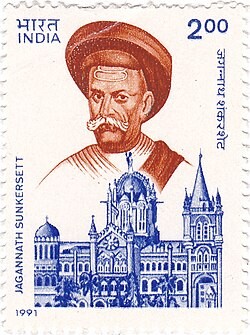Jagannath Shankarshet Murkute, fondly known as Nana Shankarshet, was born in 1803 to Brahmin parents hailing from Murbad village in Thane district. The responsibility of managing a highly lucrative money lending business in Bombay fell on his shoulders at a fairly young age, following the untimely demise of his father. As a Marathi, English and Sanskrit scholar blessed with consummate business acumen, he not only excelled in business and education but also raised the benchmark for purposeful philanthropy.
Taking inspiration from Sir Jamsetjee Jejeebhoy, he resolved to do his best for the larger cause of education. Here’s a snapshot of his glittering contributions:
· Helped Scottish statesman Mountstuart Elphinstone and English & Sanskrit scholar S. K. Chatre to open the Haind School in 1822, which was later rechristened as the Bombay Native Education Society
· Incepted and sponsored the Students Literary and Scientific Society (1848) and Girls’ School (1849); first-grade Anglo-vernacular School (1857); Law College (1855); Grant Medical College and its Marathi wing
· Long standing member of the Board of Education incepted in 1841, President, Agri-Horticultural Society of Western India, and Geographical Society
· Founder, The Bombay Association, 1852
· Proactive contribution towards setting up two iconic institutions of Mumbai: Sir J. J. School of Art and J. J. Hospital
· As the Municipal Commissioner, boosted healthcare services, initiated water conservation projects, sponsored efforts in the fields of Gas production and steam navigation, and helped build theatre auditoriums and crematoriums.
· Made hefty donations to esteemed organizations like the Mumbai branch of The Royal Asiatic Society, Victoria & Albert Museum, and Jijamata Garden.
One of his most exemplary initiatives merits a detailed elaboration (courtesy of Shankarsheth Pratishthan).
Ever since he came to know about the Liverpool–Manchester railway line that was inaugurated in 1830, Nana yearned to see a similar initiative rolled out in his native city. He shared his dream with Jamsetjee and Sir Thomas and Supreme Court Judge Sir Thomas Erskine Perry. The latter had first hand experience of the railway rides in England. Both were hooked on to the idea, and together the trio formed the Great Indian Railway company with the help of likeminded people including British bankers, traders, and government officials. The company then proposed the idea of the Railway to the government on July 13, 1844.
The Inland Railway Association was subsequently formed which prepared the initial blueprint of the proposed line. Soon after, the ‘Bombay Committee’ was set up and an expert named George Thomas Clark was appointed to study the potential routes. En route his visit to the estate of Kawasji Banaji, Clark reckoned Bhandup would be an ideal point for the extending the proposed line originating from the Bombay Port. He instantly prepared the technical plan for the proposed Kurla–Thane line in a way that would cause no damage to the salt pans of Sion. He named it “The Bombay Great Eastern Railway” and envisioned two trains running daily on two lines – Up and Down - at a speed of 10 mph.
Meanwhile, British capitalists got wind of these plans and quickly incepted the Great Indian Peninsular Railway in London and deputed engineer John Chapman to take charge of its Bombay Branch. Chapman met Nana and the two unanimously thought that the parallel efforts to build the railway line should be merged under one umbrella for lasting outcomes. Soon after, the Court of Directors of the East India company approved the 35 km Mumbai-Kalyan rail route in July 1848. In the first phase, the 21 mile long Mumbai–Thane route was finalised. It may be noted that the Court of Directors had initially dismissed the whole idea as unthinkable.
In February 1850, renowned English engineers and other staffers came to Bombay, and Nana allotted them office space in the vicinity of his Girgaon bungalow. The survey, planning, and allied work took an year and the laying of tracks commenced on October 31, 1850. The trial run happened on February 18, 1852 and finally on the historic day of April 16, 1853, the first train of the entire Asian subcontinent left for Thane from Boribunder station amid great fanfare at sharp 3.30 pm. The flower-laden wonder-on-wheels had 18 compartments and three locomotive engines. Among the venerated dignitaries on board were Lady Falkland (wife of Governor Falkland), Nana, and Sir Jamsetjee. Nana’s foresight and painstaking efforts thus made Bombay the epicentre of a momentous rail action, although Bombay was not the capital city of British India. This was a key development in the subsequent rise and fame of the metropolis as India’s industrial and financial capital.
Jagannath Shankarsheth breathed his last on 31 July 1865. The Asiatic Society of Bombay houses a marble statue of the towering leader, a junction in Grant Road is named after him, and a postal stamp has been dedicated to his memory. The sad fact, however, is that he is largely forgotten in the very city he helped build, brick by brick. Thankfully, his memory is aptly revived each year in the form of the Jagannath Shankarsheth scholarship awarded to the Sanskrit topper in the matriculation examination.
